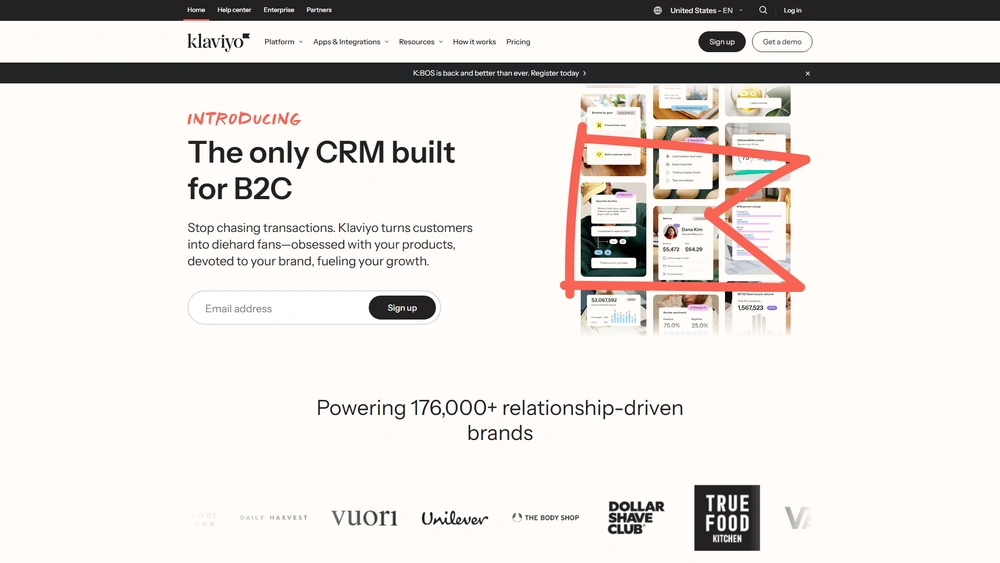Klaviyo Overview & 2025 Industry Position
Klaviyo continues to be a powerhouse in ecommerce marketing automation heading into 2025. Originally known for email marketing, the platform now offers robust SMS, customer data tools, and AI-driven personalization bundled into one seamless platform. In a digital economy that demands integration, speed, and relevance, Klaviyo users benefit from customizable automation, reliable deliverability, and detailed segmentation tuned specifically for DTC sellers and online brands.
With Shopify’s mid-2023 investment solidifying the bond between the two, Klaviyo is the default choice for thousands of growing businesses. Its 2025 focus? Hyper-relevant automation, increased AI usage, and embedded commerce experiences to drive conversion and lifetime value.
From Launch to 2025: Klaviyo’s Journey
Founded in 2012 by Andrew Bialecki and Ed Hallen, Klaviyo began as a customer analytics tool before pivoting to email automation. In 2015, it refocused entirely on ecommerce merchants, building deep Shopify integrations. Major milestones include:
- 2012: Klaviyo is founded in Boston.
- 2015: Focus pivots exclusively to ecommerce and email automation.
- 2017: Introduces SMS marketing capabilities.
- 2021: Raises $320M at $9.5B valuation.
- 2022: Shopify invests and announces Klaviyo as a strategic email partner.
- 2023: Klaviyo IPOs on NYSE (KVYO).
Heading into 2025, Klaviyo is sharpening its edge in predictive AI, segment automation, and embedded commerce channels—all designed around ecommerce efficiency and merchant growth.

Klaviyo Key Features
At its core, Klaviyo delivers multichannel automation with rich list-level data and real-time analytics. 2025’s standout features include:
- Email & SMS Automation: Sophisticated flows, drag-and-drop builders, personalized sequences.
- Customer Data Platform: Unified profiles with purchase, behavior, and lifecycle metrics.
- AI Copy & Predictive Metrics: Smart Send Time, AI subject lines, and revenue prediction tools.
- Transactional Messaging: Built-in transactional systems for receipts, shipping, and more.
- Onsite Forms & Pop-Ups: Customizable opt-in triggers, fly-outs, and exit-intent design tools.
Unlike generic marketing tools, Klaviyo flows tie directly to SKUs, checkout behaviors, and real-time store events.
Workflow & UX
Klaviyo’s UX blends power with simplicity. Even novice marketers can build complex automations using conditional logic, event triggers, and dynamic content blocks.
- Visual Journey Builder: Blueprint-style flow visualization for onboarding, churn rescue, product campaigns.
- Segment & List Views: Real-time filtering with rules for behavior, order data, or predictive lifetime value.
- Inbox Preview + A/B Testing: Simulate inbox renderings and auto-optimize with split logic.
The Shopify-native experience gives Klaviyo merchants direct access within their store portals, further streamlining UX.
Klaviyo Pricing Analysis & Value Metrics
As of July 2025, pricing is tiered by contact count and includes access to email or SMS, with combo plans available. Core tiers:
| Plan | Email (5K contacts) | SMS Add-On | Key Inclusions |
|---|---|---|---|
| Free | $0 (Up to 500 contacts) | Pay as you go | Basic flows, 150 SMS credits |
| Email Standard | $60/mo | Add +$20–$90 | Full flows, A/B tests, advanced analytics |
| Email + SMS | $95/mo | Included | Full suite, priority support, 5K SMS/mo |
Klaviyo also offers predictive calculator tools to estimate ROI based on list size—ideal for scaling efficiently without marketing bloat.
Pro Tip: Use Klaviyo’s Smart Send Time and predictive churn modeling to uncover subscriber windows before they disengage.
Competitive Landscape
| Platform | Best For | Price (5K Contacts) | Key Differentiator |
|---|---|---|---|
| Klaviyo | Shopify DTC | $60–$95 | Native commerce signals |
| Mailchimp | SMBs, generalists | $65 | Simpler UI, broader integrations |
| Omnisend | Multichannel starters | $59 | Gmail targeting, SMS included |
| Drip | DTC & media brands | $89 | Cool templates, influencer email |
Common Use Cases
Klaviyo is tailored for direct-to-consumer ecommerce brands, including but not limited to:
- Fast-growing Shopify stores scaling from 10K → 100K revenue months
- DTC brands leveraging browse + cart abandonment flows
- SaaS integrations needing transactional and lifecycle messaging
- Product-led businesses customizing flows by SKU or CLV
Klaviyo Integrations & Ecosystem Benefits
Klaviyo boasts 300+ native integrations, with leading support for Shopify, WooCommerce, BigCommerce, Amazon, Stripe, Recharge, and even NetSuite. 2025 sees tighter loops with:
- One-click Shopify and Shopify Plus native pairing
- CRM sync with HubSpot and Salesforce
- Post-purchase apps like Gorgias, Loop Returns, and Yotpo
- Payment triggers via Stripe, Recharge, PayPal
Pros & Cons
- Pros:
- Powerful ecommerce automation tailored to DTC
- Native Shopify & Stripe integrations
- Built-in AI tools for timing, copy, and projections
- Responsive templates and testing features
- Cons:
- Learning curve for non-ecommerce users
- SMS pricing varies with volume
- No built-in CRM (reliant on third-party tools)
Final Thoughts
If you’re an ecommerce brand serious about growth, Klaviyo’s automation depth, native personalization, and customer intelligence make it a worthwhile hub in 2025. While it carries a steeper price than some generalized options, the returns in engagement and conversion typically offset the spend—especially at scale.
Best for: DTC founders, Shopify merchants, and product brands ready to move beyond simple newsletters and embrace the revenue lift of behavior-driven automation.
Klaviyo Q & A
Klaviyo is optimized for Shopify, especially post-2022 partnership. WooCommerce is supported but may lack a few Shopify-native automations.
Yes. The free tier offers limited SMS credits and SMS sign-up tools. More advanced campaigns unlock with paid SMS plans.
Yes, though B2B personalization will require custom list tagging and CRM input. It’s mainly built for ecommerce but flexible enough for B2B workflows.
Embedded product cards, multi-currency logic in flows, improved Smart Send Time algorithms, and expanded partner integrations.
No. Flows use a visual builder with no-code logic blocks. Developers can enhance with JSON or API triggers if needed.